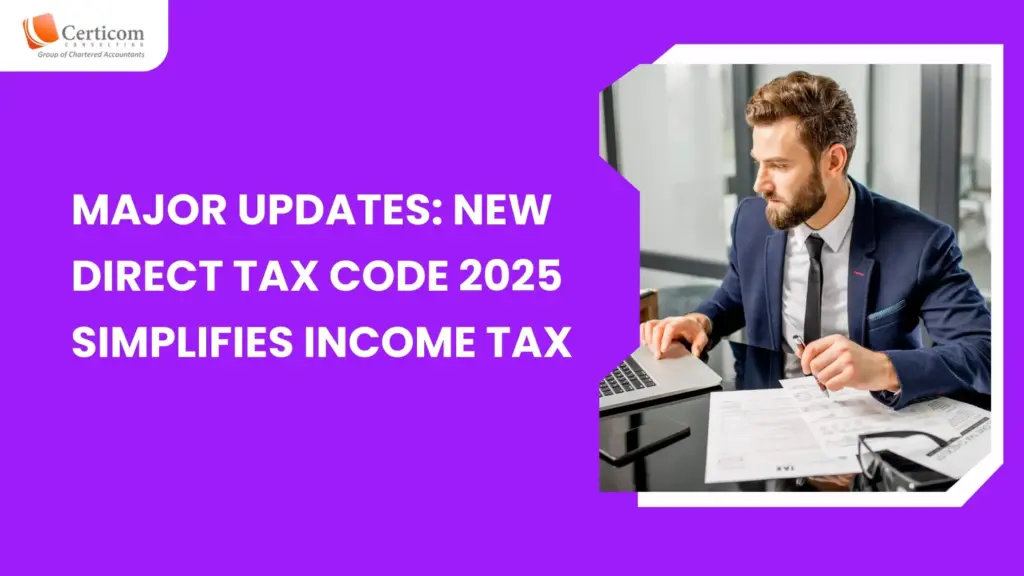Simplifying India’s Tax Landscape: Key Changes Proposed in the Direct Tax Code 2025

Have you ever found Income Tax complex, with confusing exemptions and deductions? To make taxation more user-friendly and accessible, the government has introduced the new Direct Tax Code (DTC), aimed at streamlining tax laws for everyone, from novices to experts.
Unveiled by Finance Minister Nirmala Sitharaman on August 21, 2024, the Direct Tax Code is set to simplify tax laws, encourage a more consistent business tax rate, and reduce legal disputes. Discussions on the DTC began in 2009, and it will replace the Income Tax Act of 1961 when implemented in the next six months.
What is the Direct Tax Code (DTC)?
The Direct Tax Code (DTC) simplifies the tax system, making it more transparent, modern, and user-friendly. Taking effect in the 2025-26 financial year, it will replace the Income Tax Act of 1961, cutting down complexity by eliminating redundant exemptions and deductions. The DTC also aims to reduce legal disputes and improve compliance by simplifying tax laws.
Key Milestones in the Development of the DTC
- 2009: The first draft of the DTC was introduced, intending to replace the Income Tax Act.
- 2010: A revised draft was presented, leading to the DTC Bill’s introduction in Parliament.
- 2013: The DTC was further revised based on stakeholder feedback.
- 2017: A task force was formed to draft a new direct tax law.
- 2024: Finance Minister Nirmala Sitharaman announced the DTC’s introduction.
- 2025: The DTC is expected to launch alongside the 2025 Budget.

Goals of the Direct Tax Code
The Direct Tax Code 2025 is designed to make India’s tax system easier to understand and more efficient. Its primary goals include:
- Simplifying tax rules to make them accessible to all.
- Increasing the taxpayer base from 1% to 7.5% of the population.
- Promoting compliance by making tax regulations easier to follow.
- Reducing legal disputes through clearer tax laws.
Tax Structure in the Direct Tax Code 2025
The DTC 2025 aims to modernize the tax system by reducing the number of sections and adding more schedules for simpler tax filing. Key changes include:
- Simplified Classification: Taxpayers are classified as residents or non-residents, eliminating terms like ROR and RNOR.
- Fewer Deductions and Exemptions: Most deductions and exemptions are removed, closing loopholes and ensuring fairness.
- Expanded TDS and TCS: Tax Deducted at Source (TDS) and Tax Collected at Source (TCS) will apply to nearly all income, encouraging more regular tax payments.
- Capital Gains as Regular Income: Capital gains will be taxed as part of regular income, ensuring equal treatment for all income types.
Major Changes in the Direct Tax Code 2025
Here’s a look at the notable updates in the DTC 2025:
Removal of Assessment and Previous Year Concepts
The terms “Assessment Year” and “Previous Year” are removed. Now, only the “Financial Year” will apply for tax filings.Changes in Capital Gains Tax
- Short-term capital gains on financial assets will be taxed at 20% (up from 15%).
- Long-term gains will be taxed at 12.5% (down from 20%).
Simplified Residential Status
Taxpayers are now classified simply as residents or non-residents, removing the RNOR (Resident but Not Ordinarily Resident) category.Renaming Income Categories
“Income from Salary” is now “Employment Income,” and “Income from Other Sources” is renamed “Income from Residuary Sources.”Expanded Tax Audit Roles
Company Secretaries (CS) and Cost and Management Accountants (CMA) can now conduct tax audits, previously limited to Chartered Accountants (CAs).Unified Company Tax Rates
Domestic and foreign companies will now have the same tax rate, encouraging foreign investment.New TDS and TCS Rules
TDS and TCS will apply to almost all income types, helping prevent tax evasion. TDS rates for most payments will decrease from 5% to 2%. For e-commerce operators, the TDS rate will drop from 1% to 0.1%, easing compliance.Reduced Deductions and Exemptions
While most deductions and exemptions are removed, the standard deduction for salaried employees in the new tax regime has increased to ₹75,000, a 50% rise.

How the Direct Tax Code Differs from the Income Tax Act of 1961
| Parameters | Income Tax Act, 1961 | Direct Tax Code, 2025 |
|---|---|---|
| Residential Status | ROR, RNOR, NR | Resident, Non-Resident |
| Tax Audit | Conducted by Chartered Accountants (CAs) | Conducted by CAs, CS, and CMAs |
| Concept Terms | Uses “Previous Year” and “Assessment Year” | Only “Financial Year” |
| Taxation on Dividends | Dividend Distribution Tax at 15% | Taxed at 15% without DDT |
| Tax on Distributed Income | Exemptions for income from LIC, mutual funds, etc. | Taxable at 5% |
| High-Income Tax Rate | 30% + surcharge at 15% for income over ₹10 crore | Taxable at 35% |
| Capital Gains Tax | Special rate for capital gains | Capital gains taxed as normal income |
| Heads of Income Names | Income from Salary, Income from Other Sources | Employment Income, Income from Residuary Sources |
| Sections and Schedules | 298 sections, multiple sub-sections and schedules | 319 sections, 22 schedules |
The new Direct Tax Code 2025 represents a major shift towards a more transparent, simplified, and inclusive tax system. By reducing complexity and enhancing compliance, it aims to create a fairer tax landscape for individuals and businesses alike. As the new code takes effect, taxpayers can expect easier compliance and improved clarity on tax obligations.
Related Post
Crypto Non-Filers Under IT Scanner
Income Tax Filing 2025: 6 Easy Ways to e-Verify Your ITR Online
TDS Return Form 26Q: Due Dates, Applicability & Related Forms
Book A One To One Consultation Now For FREE
How can we help? *











